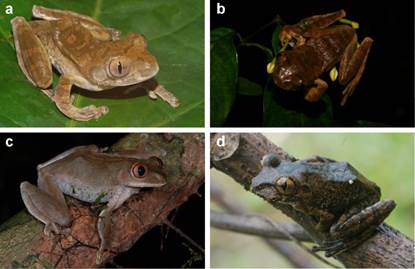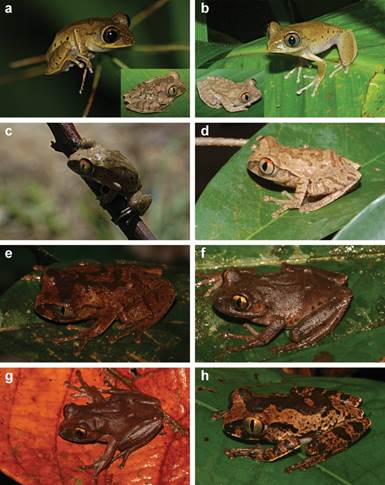一个或两个?如何决定有多少物种
来源:《Zoosystematics and Evolution》
作者:Mark-Oliver Roedel等
时间:2014-04-14


往往很难决定两个动物是属于同一或两个不同的物种。外部看起来非常相似的动物尤其具有挑战性。最近发表在开放获取期刊《Zoosystematics and Evolution》的一项研究中,柏林自然博物馆的科学家们利用遗传数据和声音分析测试了来自非洲西部和中部的树蛙属于不同或相同种。鉴于外部特征中仅大小可以用于区分这些青蛙,科学家采用其他特征确定物种属性。他们一方面利用遗传学信息,另以方面利益不同种群的广告呼叫。雄性青蛙通过物种特定的呼叫来吸引雌性,这些呼叫特性(例如持续时间、频率)能准确地辨别动物属于一个或多个种。
基于形态,意即外部相似性,两组种群以前被宣称属于同一物种。来自柏林的研究人员用分析工作证明了他们期望的正确性,并揭示他们实际上是研究的四个物种而不是两种:分别生活在非洲西部和中部的一大一小两组不同的物种。
为了方便其他研究者对这些结果的验证,遗传和声学数据都公开可用,声学数据可以从柏林自然博物馆的动物声音档案中下载。
物种是所有生物问题的基础。因此,它们不仅对分类学家非常重要,而且也是生理学家、生态学家和保育学家的参考因素。它对能否区分两个不同种群的动物属于一个或两个不同的物种至关重要。柏林和日内瓦的动物学家最近发表的研究是一个明晰的实例。
“一个同事划分过去被归为四个种的动物作为两个种,每一个现在分布在非洲西部和中部。然而,这与已知的地理事实相矛盾,地理事实显示,林蛙生活在非洲西方或者中部,但很少会同时生活在这两个地区。这个问题的澄清对于理解这些地区的地形在过去百万年间如何发展变化具有重要示范性”最近研究的作者Rödel博士解释。(编译:中国科学院成都生物研究所 王芋华,王海燕)
The taxonomic status of two West AfricanLeptopelis species:L. macrotis Schiøtz, 1967 and L. spiritusnoctis Rödel, 2007 (Amphibia: Anura: Arthroleptidae)
Abstract We herein examine the taxonomic status of two West African forest-dwelling Leptopelis species. The small L. spiritusnoctis, described from the Upper Guinean forests of West Africa, was recently synonymized with L. aubryi, described from Gabon. The large L. macrotis, known from Ghana to Sierra Leone, was downgraded to a subspecies of L. millsoni, ranging from the Niger Delta to eastern Democratic Republic of Congo. These taxonomic decisions are in contrast to the general biogeographic pattern of African forest anurans and we consequently tested if the morphologically similar taxon pairs are indeed conspecifics by applying acoustic and molecular techniques. Both techniques confirmed that populations from West Africa differ significantly from their Central African morphological equivalents. Consequently, we herein resurrect L. spiritusnoctis as a valid species. The acoustic data indicate that L. aubryi may comprise a complex of cryptic species. We further advocate using the name L. macrotis for West African and L. millsoni for Central African populations of these larger arboreal frogs. However, we had neither genetic nor acoustic data from the type locality of L. millsoni available and could not clarify if these frogs belong to the more western or eastern taxon or even represent a Nigerian endemic. Thus, it is possible that West African populations need to be termed L. millsoni in the future. For populations east of the Cross River, Nigeria, the name L. guineensis would be available.
原文链接:http://zse.pensoft.net/articles.php?id=1089#articles.php?id=1089&_suid
=13965056282400190125146704676




